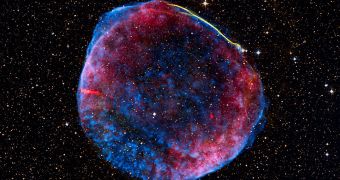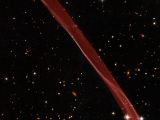The century old mystery of the origin of cosmic rays has been cracked, finally, as astronomers are now certain that they originate from supernova blasts, as has long been the belief. Despite the widely accepted premise, there was little concrete proof until now.
Cosmic rays are high energy particles, much more energetic than anything we can create in a lab on Earth, mostly protons, or, viewed another way, hydrogen nuclei. These constantly bombard the Earth but most are absorbed by the atmosphere, thankfully, as they are harmful to life.
The two prevailing theories on their origin were supernova explosions and black holes outside of the galaxy.
Now, astronomers used data gathered over four years of observations with the Fermi gamma ray space telescope and have concluded that supernova blasts are to blame.
It has long been known that supernova explosions should be able to generate high-energy particles. The shockwaves of the explosion travel at a fast speed, their magnetic fields trapping protons and accelerating them to speeds near the speed of light.
These protons collide with slower moving ones, resulting in pions, highly unstable particles made up of a quark and an antiquark.
Pions don't last long and in turn decay into pairs of gamma ray photons. It's these photons that the Fermi space telescope detects.
The decay of pions produces gamma rays in a very specific range, detecting gamma ray photons in this range is a clear indication that high-energy proton collisions are the source.
Because gamma ray photons are not affected by magnetic fields, they travel in a straight line and can be traced back to their origin, in this case the supernovas that created them.
Cosmic rays scatter in every direction and can't be traced back to a single point of origin. The gamma ray photons found by astronomers are clear proof that supernova shock waves generate the high-energy protons that eventually make their way to Earth.

 14 DAY TRIAL //
14 DAY TRIAL // 
